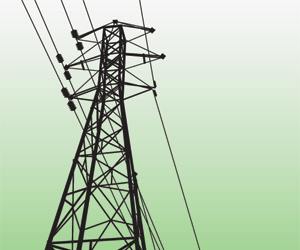Wind Power Waiting on Transmission-Line
Boom
Jul 25, 2008 - Dave Englander - greentechnmedia.com
Transmission lines are becoming the single-largest obstacle
to the continuing growth of U.S. wind power. But some
investors, such as T. Boone Pickens, view the barrier
as an equally large opportunity.
 |
| Transmission lines carry electric
energy from an energy generation site to the rest
of the grid. |
When T. Boone Pickens, the Texan oil tycoon, announced
plans to build the largest wind farm in the country, he
faced one big problem. There were no transmission lines
connecting his site to the rest of the electricity grid.
Pickens’ solution: He would build them himself.
This highlights the main issue facing the growth of centralized
wind power. You can’t have power without the power lines.
According to Ed Legge, a spokesman for the Edison Electric
Institute, an association of public electric companies,
it’s the old question of whether the chicken or the egg
comes first. “Do you build the bridge first or the source?”
he said.
Wind is alluring because it’s the cheapest green energy
to produce, and it is far less expensive than solar power,
for example. The United States this year has overtaken
Germany as the world’s No. 1 wind-power producer, according
to the American Wind Energy Association, and the sector
has the potential to grow far larger. The U.S. Department
of Energy forecasts wind power could reach 20 percent
of the nation’s power supply by 2030, up from about 1
percent today.
But wind developers – some not as well capitalized as
Pickens – are wary of building wind farms where there
are no transmission lines, even if that’s also where the
most wind blows. They fear their investment will dry up
with no lines to deliver the power. And make no mistake:
Transmission lines are expensive.
The DOE estimates that reaching 20 percent wind power
will cost $60 billion in new wind-power transmission by
2030. But that cost spells an attractive opportunity for
deep-pocketed entrepreneurs like Pickens.
The need for new grid infrastructure is by no means a
new discussion. For the last twenty years, the nationwide
power grid has suffered from chronic underinvestment.
A DOE study notes that the annual investment in transmission
lines had fallen from $5.5 billion in the early 1970s
to below $3 billion in the 1990s. In fact, in 1998, utilities
spent less than half of what they did in 1975.
Over this same time period, the country’s generating
capacity has steadily increased, adding to the distressed
grid’s troubles.
Deregulation is partially to blame. In deregulated markets,
utilities are required to share their transmission lines
to promote competition. But in this system, they have
little financial incentive to maintain and build more
lines. Profits increase the longer the equipment is in
use, discouraging updates and repairs. In particular,
public utilities, who must answer to shareholders, have
a difficult time justifying building new lines. After
all, the utility is no longer the sole beneficiary of
the investment.
These issues have created a grid system that is outdated
and – in some cases – falling apart. Power outages have
become commonplace, and they’re expensive. The largest
blackout in North American history, in August 2003, affected
some 50 million people in Canada and the United States
and resulted in damages of about $6 billion.
Wanted: Total Grid Overhaul
It will take a building boom in new lines to add a significant
amount of wind to the grid.
For one thing, with wind power, there’s the issue of
distance. Developers like Pickens – who chose remote West
Texas as his wind site – are looking at locations increasingly
off the grid to harness the strongest wind.



